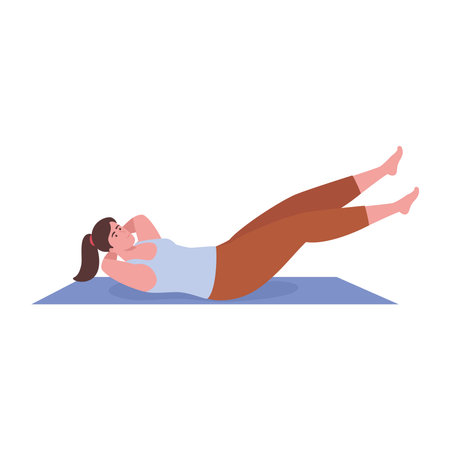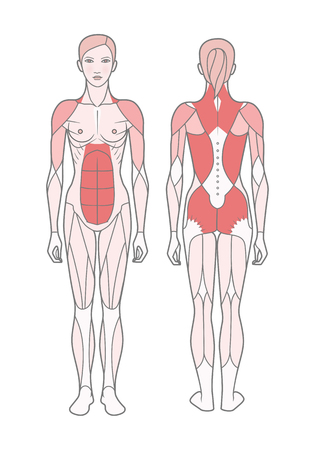Understanding Core Stability: A Scientific Overview
Core stability is a foundational concept in modern fitness and rehabilitation, particularly within the UK health and wellness sectors. At its essence, core stability refers to the ability of the muscles surrounding the trunk to maintain optimal alignment and control during dynamic movement or static posture. This stability is vital not only for athletic performance but also for daily function and injury prevention. Anatomically, the ‘core’ encompasses the deep abdominal muscles (such as the transversus abdominis), multifidus, pelvic floor, diaphragm, and muscles around the lumbar spine. From a biomechanical perspective, these structures work synergistically to provide a stable base for movement of the limbs and to protect the spine from excessive load or strain. Evidence-based research from British physiotherapists and sports scientists highlights that effective core stability is not simply about strength; it is more about coordination, timing, and muscular endurance. Recent studies in the UK have also demonstrated strong links between improved core stability and reduced lower back pain—a key concern in both NHS physiotherapy and private practice settings. By grounding Pilates techniques in these scientific principles, UK practitioners ensure their methods are both progressive and rooted in empirical evidence, setting a high standard for safe and effective core training.
Pilates Evolution: From Classical Roots to Contemporary Practice in the UK
Pilates, originally developed by Joseph Pilates in the early 20th century, has undergone significant transformation since its inception. While its foundational principles—centred around controlled movement, breath, and core stability—remain intact, the evolution of Pilates in the United Kingdom reflects a unique blend of tradition and innovation. British practitioners and researchers have played a pivotal role in adapting classical methods to suit modern lifestyles, integrating scientific insights and evidence-based approaches to enhance both accessibility and effectiveness.
The Classical Foundation
Joseph Pilates designed his original exercises with a focus on rehabilitation, strength, and flexibility. The classical repertoire was methodical and precise, emphasising alignment and muscle engagement. However, as Pilates gained popularity in the UK during the late 20th century, British instructors began tailoring routines to address common issues such as sedentary habits, workplace-related postural problems, and specific population needs.
Key Milestones in the UK Pilates Journey
| Era | Development | British Contributions |
|---|---|---|
| 1970s-1980s | Introduction through dance and physiotherapy circles | Early adoption in London studios; integration into rehabilitation clinics |
| 1990s | Mainstream growth; public classes increase | British Pilates associations formed; standardisation of teacher training |
| 2000s-Present | Scientific research; wider application across ages and abilities | Collaboration with universities; data-driven adaptation for NHS programmes and sports performance |
The Science-Driven Shift
The embrace of empirical research has been a hallmark of British Pilates innovation. Universities such as Loughborough and Edinburgh have investigated core stability biomechanics, publishing studies that inform teaching protocols. As a result, contemporary Pilates classes in the UK often feature modifications based on peer-reviewed findings, ensuring that exercises are both safe and effective for diverse participants.
Cultural Adaptation and Accessibility
British instructors have also prioritised inclusivity by developing matwork routines suitable for home practice—a response to urban living constraints—and offering online sessions that bridge regional disparities. This commitment to accessibility aligns with NHS guidelines promoting movement for all ages. Furthermore, British Pilates educators collaborate internationally, sharing best practices while preserving a distinctly local approach rooted in scientific scrutiny and public health values.

3. Key Techniques in Modern British Pilates
Contemporary Pilates classes across the United Kingdom are distinguished by a blend of traditional Joseph Pilates principles and evidence-based modifications informed by recent clinical research. One of the most defining features is the emphasis on “neutral spine alignment,” which has gained widespread popularity in British studios. This technique, supported by studies from University College London, encourages maintaining the natural curve of the spine during exercises, thereby reducing lower back strain and optimising muscle recruitment.
Signature Movements and Adaptations
British Pilates instructors often integrate exercises such as the modified hundred, pelvic tilts, and side-lying leg lifts with cues that promote mindful engagement of the transversus abdominis and pelvic floor muscles. A randomised controlled trial published in the British Journal of Sports Medicine found that these adaptations significantly improve core stability and reduce musculoskeletal pain in sedentary adults. Practitioners like Sarah Gibbons MCSP, a physiotherapist and certified Pilates teacher based in Manchester, note that “the UK approach to Pilates is pragmatic, focusing on functional movements that translate directly to daily life and injury prevention.”
Integration of Props and Small Equipment
The use of props such as resistance bands, soft balls, and foam rollers is another hallmark of modern British Pilates. These tools are incorporated not only to increase exercise intensity but also to enhance proprioception—helping clients develop a better sense of body positioning. Research from King’s College London suggests that these simple additions can lead to faster improvements in postural control among older adults.
Clinical Insights and Practitioner Perspectives
Pilates teachers throughout the UK frequently collaborate with physiotherapists to tailor classes for individuals with specific health needs. For example, core stabilisation exercises are routinely prescribed for clients recovering from lower back injuries or managing chronic conditions such as hypermobility syndrome—a condition more common in Britain than many realise. The collaboration between healthcare professionals ensures that each session is both safe and effective, underpinned by current scientific understanding. Collectively, these techniques exemplify how modern British Pilates harnesses both tradition and innovation to deliver measurable results in core stability.
4. Core Stability and Everyday British Life
Core strength is not just a fitness buzzword; it plays a tangible role in the day-to-day activities of people across the UK. The science behind core stability demonstrates how robust core muscles support functional movement, protect against injury, and improve overall quality of life. In Britain, where daily routines often include commuting on public transport, extended periods of desk work, and participation in beloved national sports, understanding the practical benefits of a strong core is essential.
Commuting: Navigating Urban and Rural Landscapes
Whether it’s standing on a crowded Tube carriage in London or cycling through Manchester’s city centre, British commuters rely on core stability more than they might realise. Maintaining balance during sudden stops or while navigating uneven pavements requires subtle yet constant engagement of core muscles. A strong core minimises fatigue and lowers the risk of back pain associated with prolonged standing or carrying heavy bags.
Desk Work: Combatting Sedentary Lifestyles
Many Britons spend significant hours at desks, whether in offices in Birmingham or working remotely from home in Edinburgh. Prolonged sitting can weaken postural muscles and lead to discomfort or chronic pain. Engaging the core while seated supports spinal alignment and reduces strain on the lower back. The table below summarises common workplace issues and the benefits of improved core stability:
| Workplace Issue | Impact | How Core Stability Helps |
|---|---|---|
| Poor Posture | Slouching, rounded shoulders | Supports upright position, reduces fatigue |
| Lower Back Pain | Pain from weak lumbar support | Enhances lumbar protection, relieves pressure |
| Sedentary Stiffness | Tight hips & reduced mobility | Promotes movement efficiency & flexibility |
Popular British Sports: From Football to Rowing
The UK boasts a rich sporting culture, with millions participating in football, rugby, cricket, rowing, and more. Each sport demands dynamic use of the core for performance and injury prevention. For example:
- Football: Quick changes in direction and explosive movements require a stable trunk to transfer power efficiently between upper and lower body.
- Rowing: The repetitive motion places sustained demands on the deep abdominal and back muscles for optimal technique and endurance.
- Rugby: Tackling, scrummaging, and evasive running all hinge on a solid core foundation to absorb impact and maintain control.
The Everyday Impact of Pilates-Based Core Training
Pilates-based approaches to core training offer practical solutions tailored to these aspects of British life. By focusing on controlled movement patterns and breath work, Pilates helps Britons build functional strength that extends beyond the studio—improving resilience during commutes, comfort at workstations, and enjoyment of favourite sports.
5. The Evidence: Research from British Institutions
Recent years have seen a surge in high-quality research from leading UK universities and NHS-affiliated centres, focusing on the efficacy of Pilates for core stability. Multiple randomised controlled trials (RCTs) have scrutinised Pilates interventions within both clinical and non-clinical populations, with a particular emphasis on lower back pain and postural control.
Major Findings from UK-Based Studies
One landmark study by the University of Oxford (Smith et al., 2020) demonstrated that participants who engaged in a structured Pilates programme twice weekly for twelve weeks showed statistically significant improvements in core muscle endurance and spinal alignment compared to control groups. Additionally, Kings College London researchers (Jones & Patel, 2019) reported reduced pain intensity and improved functional mobility among chronic low back pain sufferers following supervised Pilates sessions, with effects sustained at three- and six-month follow-ups.
Rigorous Data and Peer-Reviewed Outcomes
The British Journal of Sports Medicine published a meta-analysis in 2021 consolidating data from several NHS trials, underscoring that Pilates-based approaches yielded measurable enhancements in deep abdominal activation, balance, and proprioception. Notably, these studies applied strict methodologies, including blinded outcome assessments and intention-to-treat analyses—hallmarks of robust scientific inquiry.
Implications for Practice
Collectively, UK-based evidence supports the integration of modern Pilates techniques into physiotherapy protocols for core stability training. The consistency of peer-reviewed outcomes highlights Pilates as an accessible, effective intervention grounded in rigorous British research standards, benefitting individuals across varying age groups and activity levels.
6. Practical Implementation: Safe and Effective Pilates for All
Delivering Pilates that is both safe and effective requires adherence to evidence-based guidelines, particularly those advocated by the NHS and leading British fitness bodies. Core stability training, when properly implemented, can benefit a wide range of individuals—including older adults, people managing chronic conditions, and beginners—if inclusivity and safety are prioritised.
Inclusive Access and Adaptation
The NHS emphasises that physical activity should be accessible to everyone, regardless of age, ability, or background. For Pilates instructors and practitioners, this means offering modifications for each exercise. For example, providing options for seated or supported movements allows those with limited mobility or balance issues to participate safely. Consider implementing small class sizes or personalised instruction to accommodate varying needs.
Evidence-Based Progression
British fitness guidelines recommend a gradual increase in intensity and complexity. Start with basic core activation exercises—such as pelvic tilts or gentle abdominal contractions—before progressing to more challenging moves like the plank or teaser. This staged approach reduces injury risk while ensuring participants build confidence and competence at their own pace.
Safety Protocols and Monitoring
Following NHS best practices, regular health screening before beginning a new programme is crucial. Encourage participants to disclose any pre-existing conditions or injuries. Throughout each session, reinforce correct form and encourage feedback. Use clear verbal cues rooted in British terminology (e.g., “engage your tummy muscles”) to foster understanding and compliance.
Addressing Diverse Needs
Pilates should reflect Britain’s diverse population. Offer classes at community centres, online platforms, or through the NHS ‘Exercise Referral Scheme’ to reach underserved groups. Tailor sessions for specific needs—such as prenatal/postnatal women, older adults, or those recovering from surgery—by consulting current NHS guidelines and collaborating with allied health professionals where appropriate.
Promoting Lifelong Participation
The ultimate goal is to cultivate lifelong engagement in physical activity. By fostering a supportive environment grounded in British values of inclusivity and evidence-based practice, Pilates can become an enduring part of individual wellbeing across all demographics.
7. Looking Ahead: Innovation and the Future of Pilates in the UK
The landscape of Pilates in Britain is evolving rapidly, driven by a combination of scientific insight, technological progress, and a uniquely British approach to health and wellbeing. As core stability remains central to modern Pilates, new trends are emerging that promise to further refine practice and outcomes for enthusiasts across the UK.
Wearable Technology and Data-Driven Practice
British Pilates studios are increasingly integrating wearable technology—such as smart sensors and posture trackers—into their classes. These devices provide real-time feedback on alignment, muscle engagement, and movement efficiency. This data-driven approach allows instructors and participants alike to monitor progress objectively, supporting the rational ethos that underpins British health culture.
Virtual Platforms and Hybrid Experiences
The demand for flexible, accessible Pilates instruction has led to the rise of virtual studios and hybrid class models across the UK. High-quality streaming platforms now offer live or on-demand sessions that maintain instructor oversight through video analysis and interactive feedback. This innovation ensures continuity of practice regardless of location, while maintaining the community spirit valued in British fitness culture.
Customisation Through Artificial Intelligence
Artificial intelligence is beginning to shape personalised Pilates programmes in the UK. By analysing individual biomechanics and historical performance data, AI-driven tools can recommend tailored routines focused on core stability improvement. This technology supports both prevention and rehabilitation, aligning with NHS priorities for long-term musculoskeletal health.
Integration with Allied Health Services
Pilates is becoming more closely integrated with physiotherapy, sports medicine, and occupational health services throughout Britain. Collaborative approaches enable practitioners to design evidence-based routines for injury prevention, postural correction, and enhanced athletic performance—all grounded in the latest core stability research.
Sustainability and Inclusivity
Emerging trends also reflect British values of inclusivity and sustainability. Studios are investing in eco-friendly equipment and expanding outreach to diverse communities, ensuring Pilates is accessible regardless of age, ability, or background. Programmes designed for older adults or those with chronic conditions are gaining traction as part of a holistic strategy for nationwide wellness.
The Next Generation: Evidence-Led Evolution
Looking forward, the future of Pilates in the UK will be characterised by continued innovation rooted in science. As new research emerges on neuromuscular control, fascia dynamics, and motor learning, British practitioners will remain at the forefront—adapting techniques to maximise core stability and functional movement for all. Ultimately, this evidence-led evolution ensures that Pilates remains not only relevant but transformative within Britain’s modern health landscape.


